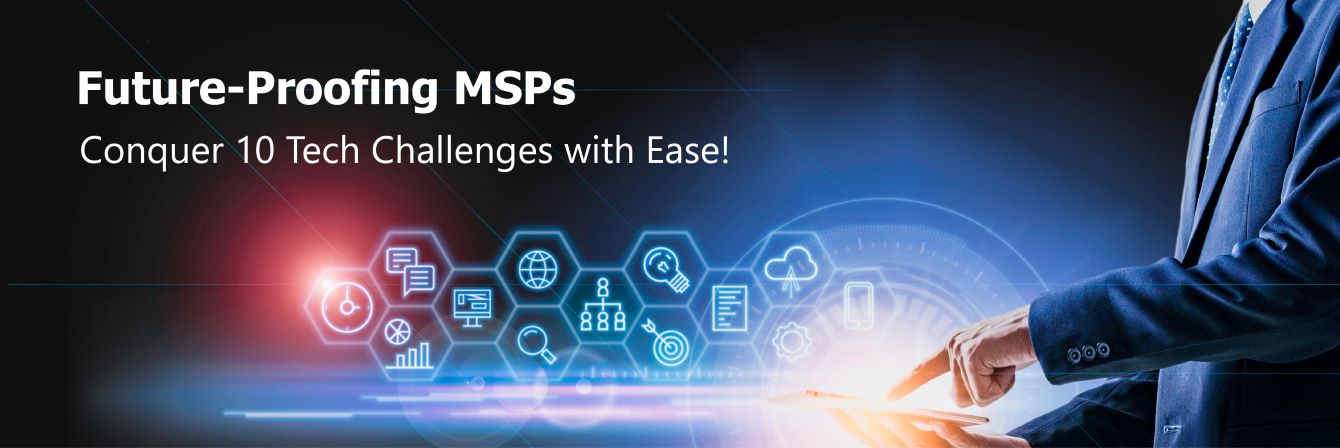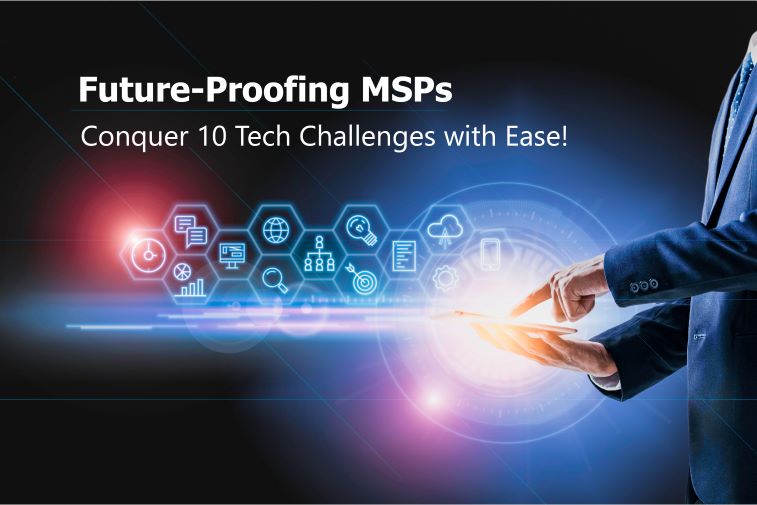
In the fast-paced, evolving landscape of mobility management, managed service providers (MSPs) must continue to improve speed and agility to meet changing customer demands and maintain a competitive advantage. Meanwhile, IT teams face mounting pressure to adapt quickly while managing the complexity of multiple customers, security, compliance and much more.
While automation is playing a large role in enabling these companies to adapt, IT leaders must also consider factors such as system unification, cybersecurity and visibility. Staying on top of these developing trends and challenges is crucial to achieving sustained business success.
To help keep you up to date, we’ve put together a list of the top 10 challenges (and solutions) to look out for in 2023 and beyond.
1. Centralizing Fragmented Tools and Siloed Data
Historically, MSPs have had few, if any, platforms tailored to mobility management. This forced many to adopt tools like telecom expense management (TEM) platforms, which often required a high degree of customization or added costs for unnecessary functions. With increased expenses, inefficiencies and a patchwork of disparate tools and systems, many struggled to deliver complete end-to-end mobility-managed services.
Zero-touch solutions allow MSPs to link to Customer backend systems, giving them access to needed foundational data (HR/EMM/AD/SSO). This linkage allows the MSP to better manage the Customer’s inventory and end-user support.
2. Automating Manual Processes
As customer demands push MSPs toward faster service delivery, manual processes can become a significant obstacle to efficiency. Whether it’s device configuration, inventory management carrier account provisioning or device troubleshooting, these time-consuming, repetitive tasks can quickly drain your IT resources — not to mention, they’re often prone to errors.
Automating these manual processes with a zero-touch management solution, and a base platform like ServiceNow acting as a central control tower for desperate siloed systems, can streamline operations and maximize productivity while ensuring a consistent and accurate execution every time.
3. Simplifying Management Complexity
MSPs rarely get access to integrate customer management platforms with inventory, HR or financial systems. This siloed data can lead to inaccuracies, inefficiencies and limited visibility into the mobile environment, requiring IT teams (and customers) to swivel chair between multiple data sources and applications and/or synchronize whatever data the Customer can provide through clumsy methods like flat file exchanges.
With a zero-touch mobile management solution, MSPs can seamlessly link customer systems with other internal systems, eliminating swivel chair activities, fragmentation and inaccuracies. This provides IT teams with comprehensive visibility and easy access to the data they need, enabling them to manage mobility services from a centralized platform. To complete this view, mobility-focused MSPs are currently considering the adoption of platforms such as ServiceNow to natively integrate the major players in Enterprise Mobility.
4. Optimizing Processes and Operations
Inefficient, manual processes within mobility management can (and do) have detrimental impacts on the overall performance of an MSP. Yet most companies struggle to manage basic mobility, significantly limiting the power and capabilities of new and advanced mobile devices. Instead, most offer the same personal information management (PIM) and email capabilities they did on legacy devices like the Blackberry in the early 2000s. As such, the value and utilization of enterprise mobility are far lower than they could be.
To address these challenges, many MSPs are embracing zero-touch management as a way to optimize processes and operational efficiency. Zero-touch solutions can eliminate human errors and streamline tasks, freeing up IT teams for higher-value tasks. They can also enhance an MSP’s scalability, allowing them to manage a much larger volume of customers without the need to significantly increase their workforce.
5. Maximizing Productivity
Employee onboarding and offboarding processes can be tedious and time-consuming, leading to issues with engagement, efficiency and productivity. On the other hand, companies with a seamless onboarding experience can increase new hire retention by up to 82% and productivity by 70%.
With the adoption of a zero-touch approach, MSPs can streamline these processes and many others, maximizing productivity and efficiency. By using ServiceNow as a central control platform, companies can also integrate mobility management with finance or HR systems, such as WorkDay, enabling seamless data exchange.
MSPs can also integrate with their enterprise customers’ systems to facilitate automated transactions. This integration can help ensure, among other things, that a new employee has their mobile device and notebook on Day 1 of the job.
6. Increasing Deployment Speed
In today’s fast-paced managed service landscape, customers demand speed. To stay competitive, MSPs need to reduce deployment timelines and deliver their services as quickly as possible. At the same time, economic uncertainty necessitates that IT teams do more with less.
So, what’s the solution? Hyperautomation.
With a zero-touch solution, MSPs can leverage hyperautomation to eliminate repetitive tasks, reduce the need for human intervention and optimize operational and process efficiency — all in one. This enables IT teams to accelerate deployment timelines at reduced costs, meeting customer expectations which, in turn, provides MSPs with a competitive advantage.
7. Expanding End-to-End Visibility
Due to fragmented tools and scattered data sources, mobility managers often struggle to gain a comprehensive view of their mobile environments. Whether it’s restricted access to information from another department or swivel chairing between systems, this poor visibility obscures important insights, limiting effective decision-making.
However, MSPs are leveraging zero-touch management solutions to break down these silos and unify all the data and tools they need on a single platform. By integrating and consolidating these disparate systems behind a single pane of glass, IT teams can achieve end-to-end visibility into the entire mobile management lifecycle. With better monitoring, in-depth analysis and data-backed decisions, MSPs can maximize operational efficiency and customer satisfaction, becoming proactive and preventative in their support.
8. Minimizing Downtime
Mobility managers often lack proactive workflows and response measures to unexpected events, leaving them vulnerable to costly issues and downtime when a device is lost, stolen or fails. With siloed systems, IT teams must manually trigger a response, leading to delayed response times. Meanwhile, every hour or day a lost device goes without a wipe, lock or carrier account suspension increases your risk of exposure.
To avoid these issues, MSPs are increasingly leveraging analytics and diagnostic information, as well as data from management platforms, such as enterprise mobility management (EMM) and unified endpoint management (UEM) platforms. With zero-touch solutions, IT teams can use this data to proactively address potential risks and device failures, ensuring operations run uninterrupted.
9. Mitigating Cybersecurity Threats
Increasing cybersecurity threats across all industries have raised concerns for companies — but especially MSPs with expansive mobile fleets. And when the average breach costs a company around $8.6 million, it’s clear why protecting data matters. IT managers need a solution that can automatically deploy security software, manage updates across all corporate-owned devices, and ensure compliance.
Zero-touch management offers an effective approach to improving security, allowing IT managers to centralize control and streamline management across the entire device fleet. With automated updates, MSPs can ensure they maintain consistent and effective security measures to reduce vulnerabilities and protect sensitive data.
10. Improving Cost Management
Cost management is a top priority for mobile fleet managers, who need to detect and address potential issues with corporate devices to optimize maintenance, replacement, delivery and disposal schedules. Without effective control, expenses can quickly add up, impacting the bottom line.
To put it into perspective, 42% of devices returned for repair are for battery-related issues, while downtime costs an average of $5,000 per incident. Assuming an average break rate of 10% for a device fleet of 10,000, that’s 1,000 devices that need repairs or replacement each year — of which 400 are due to battery issues. Multiply 400 devices by $5,000, and that’s effectively $2 million in potential savings if you use a system that can detect battery issues and process a remediation action before they become a significant problem.
Zero-touch mobility solutions can proactively detect a variety of potential device issues, including battery health, enabling timely interventions to minimize costly failures or downtime.
Zero Touch Mobility Management From Samsung SDS
Samsung SDS Zero Touch Mobility is a cutting-edge solution native to ServiceNow. It’s designed to address the evolving needs of MSPs and their customers by centralizing tools and data, automating manual processes and providing a comprehensive view of mobile environments. Zero Touch Mobility enables your MSP to gain end-to-end control of the enterprise mobility lifecycle on a single platform — allowing for easier integrations between MSP and Customer systems.
Utilizing Zero Touch in your ServiceNow instance, you can:
➢ Eliminate silos and swivel chairing.
➢ Gain easier access to foundational data (HR/EMM/Etc).
➢ Simplify forward and reverse logistics.
➢ Automate deployment and support workflows.
➢ Optimize cost management.
➢ Identify and resolve issues proactively.
Here’s what our customers have to say about Zero Touch Mobility:
Hyperion Partners: The Potential of Zero Touch
Hyperion Partners is a managed mobility services provider, specializing in field services and retail organizations. After struggling to manage their multiple large enterprise customers with fragmented tools and processes, they realized they needed a better solution.
That’s when Hyperion turned to Zero Touch Mobility From Samsung SDS. With Zero Touch Mobility, they’re able to manage and automate device deployment while building standard processes for support on the zero-touch platform.
"In today’s digital age, speed is at the core of a successful mobile experience. Samsung SDS’s Zero Touch Mobility solution will allow us to harness the data of our mobile fleet, streamline the process and save costs — so we can deliver fast and stay agile." Contact Us and Learn More about ZTM solution.
- Evan Tomlin, CTO at Hyperion Partners
Connect with Us
